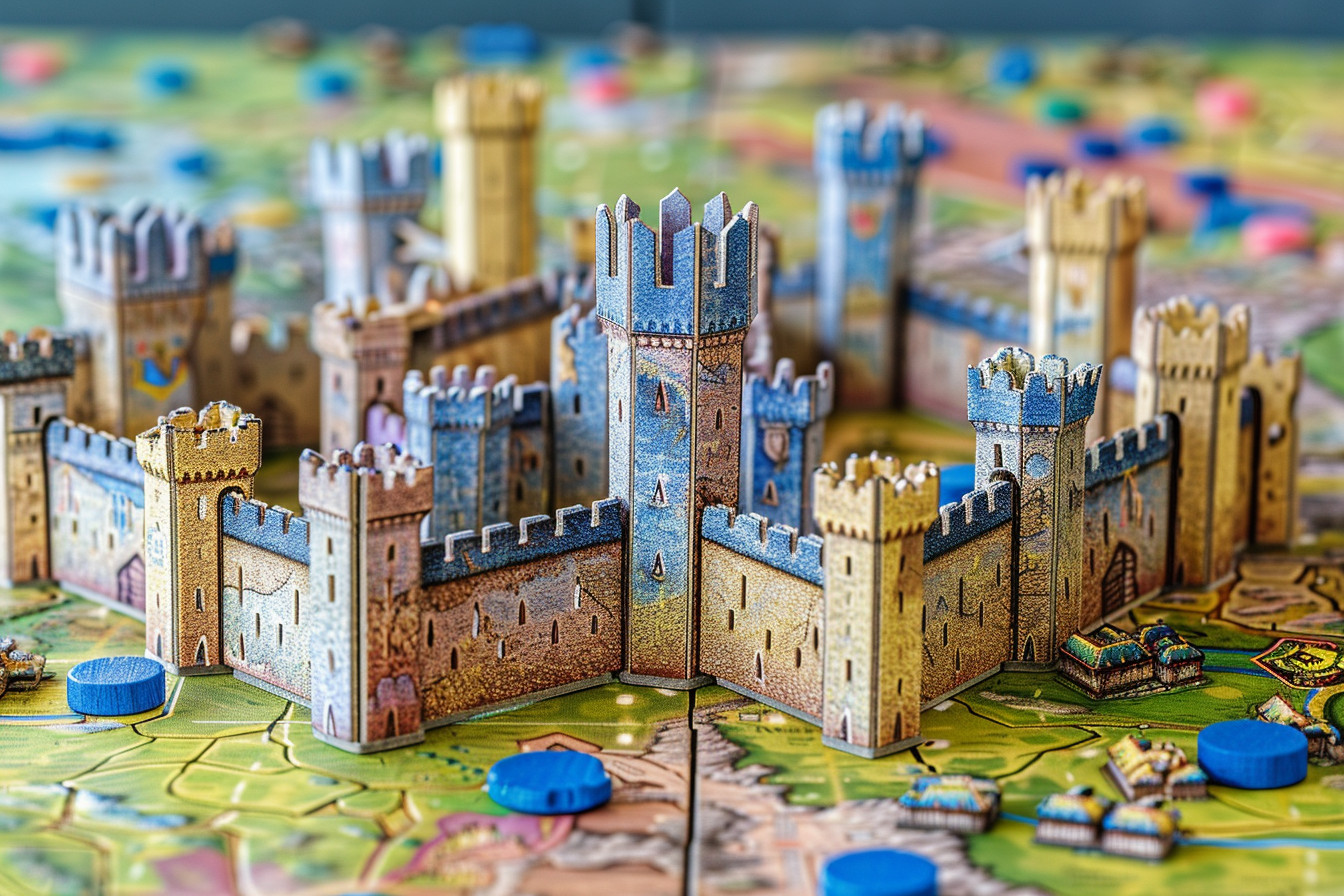Viticulture is a game that swiftly makes you forget your surroundings and transports you to its alternate reality—the peaceful vineyards of Tuscany. As one of the country’s more devoted board game aficionados, this particular game is saved on my shelf. Players in this worker-placement game are transformed into winners. Every round, you must play worker cards for various actions, all in the hope of making the best wines. This game’s appeal lies in its faithfulness to the customs of that particular industry, and I can personally testify that playing it over and over again never bores you. It includes so many elements that make for a good game in the first place that it is little wonder that Viticulture was my introduction to this type of genre.
One thing that attracted me to viticulture is how deftly it combines the best of both logic and chance. In viticulture, you start with a small number of fields, a modest vineyard, workers, and expensive wines—perhaps not that many—everyone from there plants vines that need them to grow on harvest grapes. The feel of making wine is so well captured in this game that, as you play, it can almost be tasted immediately. However, Vitalitucre greatly differs from other worker-placement games.
What sets viticulture apart is its seasonal structure. The game consists of four seasons, each with its own unique series of actions and possibilities. This seasonal rhythm adds a layer of realism and complexity—you must always carefully consider ahead exactly where you should move pieces to gain efficient benefit at any time when attacking back against opponents.
The first time I played viticulture was at a friend’s game night. We were all longtime gamers, yet this game, with its thematic richness and strategic depth, immediately riveted us. As we competed to fill orders and improve our vineyards, we could almost taste the excitement in the air. .
Setup
When setting up viticulture, I find the whole process enjoyable in itself, almost as much so as playing the game. The game components are of high quality, from the wooden worker meeples to the richly illustrated board. The process begins with the main board, which shows a picturesque vineyard divided into various action spaces for each season. Each player also has their own vineyard board, on which they will manage their shoots, their wine cellars, and the buildings.
Each player has a set of workers to start with, including the special “grande” worker that can be placed in occupied spaces. Players also receive a number of vine and visitor cards, which are an integral part of the game. The vine cards represent different grape varieties that you can plant in your fields, while the visitor cards offer various bonuses and special actions.
One of the key issues in the placement phase is determining the turn order. In the wake-up order indicated by the wake-up table, another layer of skill is added. Players select their wake-up position, with earlier positions giving better bonuses and later ones awarding more workers. It can have a dramatically different effect on strategy depending on what you choose to do, not least because this determines the order in which you can place your workers each season.
There is also setting up everything else that goes on the board. This includes things like trellises, irrigation, and cellars that players can build to raise the level of their vineyards. Personally, I am one who prefers the insulation of physical elements in a game. As an essential part of the landscape, the components are not only functional but also possess artistic value. And the whole feeling is more complete and immersive.
One particular setup I remember clearly I was at a family gathering. My parents, neither of whom really cared for board games, were interested because they liked the pretty and wine-making theme of this game. As we put in place all the various parts of the setup, rules were explained. Their initial skepticism turned into interest, and by the time everything was set up, they could not wait to start planting trees and making wine.
Playing the Game
Playing viticulture takes players through the wine-growing year, with each season presenting special opportunities and problems. The game begins in spring, where players determine the order for the year. This is strategic, as it influences bonuses received and worker placement possibilities later on. When to wake up is a decision of startling importance, setting the tone for your play throughout this finely crafted game.
In the summer, the pace picks right up. Players send workers to various action spaces, allowing them to plant vines, give tours, draw vines, and collect visitor cards. Each action requires careful consideration. The number of available spaces is limited, especially in games with more players. This often sparks intense competition to perform the most valuable actions. I fondly remember a particularly tense game. I desperately needed to plant a vine in order to fill an order, but my opponent took the last space. The frustration and subsequent strategic adjustment only served to increase the fun and difficulty of the game.
New visitor cards are drawn as fall arrives. Such cards can either give players powerful benefits or else upset the plans of their opponents. They make the game very thrilling because they contain a nice surprise that can really turn it around. During one game night, I drew a visitor card that let me harvest grapes and make wine in one turn, and suddenly I had jumped into the lead just as I was beginning to fall behind again. The timing and use of these cards are very important, adding extra depth to strategy.
Winter is the season in which players harvest grapes, make wine, and fill orders. This is often the most intense phase because players struggle to fetch for themselves their objectives and win points. The worker placement spots (locations where you can send one of your workers) are once again hard-fought over; the choices you make here can mean victory or defeat. I remember a game where I just managed to beat my friend because I filled a big wine order in the last turn, earning just enough points to win. It’s moments like that that make me keep coming back to viticulture.
Throughout a game, players may also construct buildings that offer benefits in a variety of ways, such as increasing storage space for grapes or providing additional sites on which workers can be placed. Balancing this construction with other actions is one key element of the strategy.
Advantages
Viticulture is a superb board game that boasts many strengths. One of its most striking features is the way it brings immersion to its theme. The setting and mechanics are so well integrated that you really feel like an estate manager taking care of vines. From the planting of vineyards to the aging of wine, each action is totally steeped in that spirit-making for exciting but also satisfying gameplay.
Another key advantage is the seasonal structure. Splitting the game into four distinct seasons not only adds an extraordinary level of realism for the player but also adds a very high degree of strategic depth. Each season offers opportunities and unique actions that call for players to plan ahead and adapt their playing styles according to changing conditions. This kind of structure keeps the game lively and prevents any one strategy from becoming monotonous, ensuring that it is fresh each time it is played.
The components and artwork are the best. There are beautiful illustrations on the cards, and the board itself depicts a Tuscany vineyard all the way down to its most minute details. Wooden tokens and meeples, too, are of such high quality that you can feel their excellence. The entire production of viticulture is designed to be enjoyed, and each aspect adds to your pleasure in playing it.
The thing I like most about viticulture is its visitor cards. By giving your game unexpected variety or excitement, plus powerful rewards and special abilities, these cards that come in at any time can make the whole result of the game take a new direction. If it doesn’t suit you to rely on repetition and a lack of imagination for your big win, then those visitor cards may be exactly what it takes. Last time I played, a fortunate visitor card solved a sticky problem my opponents had overlooked and won me the game. With new cards added each time, each game of Viticulture is as fresh as a daisy—you never know what kind of new things it may present you with or throw at you.
Moreover, viticulture has the distinct advantage of being suitable for a range of different numbers of players. It matters not whether you play with two players or six; the feeling and balance are both good. This flexibility means that the game is great for both intimate evenings with close friends and big gatherings of acquaintances. I have played Viticulture in many different situations, from cozy two-player games at home with my girlfriend to public places like board game cafes and once even aboard a cruise ship, and all around it delivers feelings of deep satisfaction.
Cons
Overall, viticulture is a great game. However, it does have its disadvantages. First, there is the learning curve. The game has lots to explain, and new players often find it overwhelming. Teaching the game can be difficult, especially for those with no experience with worker placement mechanics. I find that the first few games with new players usually require much guidance, encouragement, and patience as they learn the different actions and strategies.
The game’s duration could potentially be seen as a negative point. Playing a complete round of Viticulture can take as much as two hours, and that’s just with three players. This can put off those who prefer quick, relaxed games. There have definitely been times when our game group has decided to opt for something a little less time-consuming because we didn’t have enough time and energy to start another session of viticulture. It’s a game that requires a lot of time investment and is often not feasible for every game night.
Another possible misunderstanding might be visitor cards. Since they depend on good fortune, one disadvantage of introducing them to the game might be considered unfair. While these cards add variety and excitement, they sometimes feel out of sync. A stroke of luck may provide a great advantage, which makes those players who desire purely strategic actions feel, well, powerless. I can remember a game where a single player continually drew powerful visitor cards and thus was well ahead. Yet while this aspect of the game keeps it exciting and unpredictable, it may also be a source of frustration at times.
Furthermore, the competitive nature of worker placement often creates friction. With only a limited number of action spaces available, people end up fighting for the same slots, and their actions are blocked or plans thwarted. This can be a double-edged sword: although it adds to the strategic depth, it can also cause frustration, especially for people who are often blocked.
To sum up, the theme for Viticulture is immersive, as it might or might not be to some people. The winemaking setting is unique and charming, but for players who like more fantastical or adventurous themes, it may leave them colder. I have introduced the game to friends who were lukewarm about the idea of managing a vineyard, preferring games with more dramatic or epic settings. For many people, the theme is a major draw, but it may restrict the game’s market appeal.
Comparisons with Similar Games
1. Agricola
Theme: Agricola requires players to act as farmers, not winemakers. They have to manage resources, grow two wheats for each one on panda-plowed fields, and feed the animals themselves.
Complexity: Agricola is more complicated and harsher on resource management. That is less forgiving to newcomers.
Interaction: Both games work from the Lyon Board location, but Agricola is sterner with a penalty for poor planning.
2. Caverna: The Cave Farmers
Theme: Just like Agricola, only with a terrible, dark overlay where players keep erecting caves on their boards as their family of dwarves.
Complexity: Caverna introduces more freedom and is less stingy on mechanisms, making it somewhat easier to handle than Agricola’s spit and polish.
Interaction: Viticulture has almost no conflict between players for action spaces, while each board in Caverna provides its own purchase area, making confrontation rare.
3. Lords of Waterdeep
Theme: Set in the Dungeons & Dragons universe, players act as hidden lords of the city, sending adventurers on quest after quest.
Complexity: Lords of Waterdeep is much easier to learn and plays faster than Viticulture, a perfect introductory worker placement game.
Interaction: Lords of Waterdeep introduces intrigue cards, which provide players with their own ways to attack other players that are not present in Viticulture.

Final Thoughts
Viticulture is a gem in the world of board games, with its blend of deep strategy, thematic immersion, and high replayability combining to make it a standout title in the worker placement genre.
The game’s seasons and its integration with theme form a plan that is convincing and compelling, for only then can players be truly content managers of vineyards who truly bring forth fine wines. “It’s a game that brings people together.” One of the reasons I love Viticulture is because it can be played by anyone, from longtime board gamers to friends of mine who are completely new to such activities.
This game also has gorgeous components and an inviting playing mechanism, helping to attract non-players into the world of today’s boardgames. I’ve seen my friends slot together their vineyards, and I’ve seen them grow with joy. These shared moments of excitement and strategy are what make old-fashioned boardgaming such a rewarding hobby.
The additional unpredictabilities and tactics provided by visitor cards and seasonal actions ensure that no two games are ever exactly the same. This problem-solving process is complex and satisfactory, as players must juggle short-term gains against long-term planning.
Although the game’s length and learning curve may be daunting, viticulture can provide an immensely gratifying experience to those who are ready to invest some time. With its ability to block actions and introduce chance through visitor cards, Viticulture just may make players feel awkward or frustrated, but these same elements also bring a dynamism and delight that break through any other obstacles. It is not only its game play that makes Viticulture special, but also the stories and memories it weaves in your heart.
Viticulture is a game that absolutely has to be in any gamer’s collection. Its depth of theme, strategic complexity, and stunning components make it a standout offering that will give you endless hours of pleasure. Whether you are a seasoned gamer or brand-new to the hobby, viticulture has something for everyone, bringing you with every play to the Tuscan hills and world of winemaking. So join your friends in a toast of your favorite wine and head off on a journey through the vineyards with Viticulture. Cheers!







